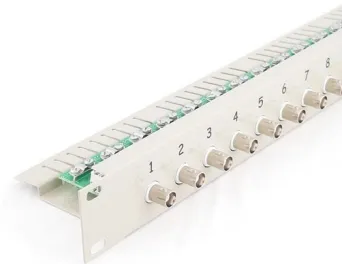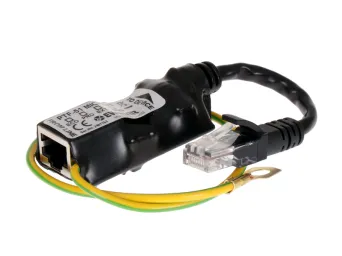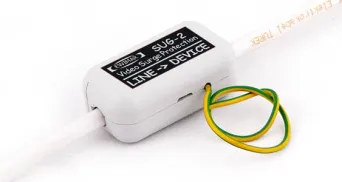How to properly protect electronics?
In order to effectively protect electronic devices in a large installation, it is necessary to obtain a lot of information that will allow for the appropriate selection of devices and their proper installation. It should be remembered that each lightning discharge is different, and each time it can create different threats due to the completely random flow of voltages and currents. Other articles describe the phenomena that occur during a lightning strike and the threats they pose to electronic devices.
First of all, it is necessary to distinguish between the importance of objects and the nature of the operation of devices. For home appliances that are connected occasionally and are easy to turn off in a lightning storm, a different surge protection system may be used as opposed to commercial or industrial buildings. Switching off devices in such facilities is often impossible for technological reasons, and any interruption in their operation causes huge losses. Due to the different construction of industrial buildings, there will also be other types of threats and a different value of the protected devices.
It is up to the designer of the surge protection system to learn about the properties of the object, assess the level and types of hazards, and then select the protection devices to meet the relevant requirements.
The solutions described below are not alternatives for each other. Each of them eliminates a different type of threat and complements the others. The best protection is obtained with as many of them as possible.
1. Lightning protection installation
It is a set of vertical lightning rods, ionizing needles, cables with high current resistance and proper grounding. Its purpose is to prevent lightning from striking random building elements by bringing most of the lightning energy to the ground. It limits the flow of the surge current through the building structures, which prevents fire and electric shock to people inside the building as a result of spark overs. The controlled flow of the main stroke reduces the risk of direct impact on exposed electronic devices, which in most cases will completely destroy them despite the installation of SPDs. It should be remembered that electronic devices must be below the lightning rod spiers and be at a considerable distance from them, which is a natural barrier against sparking.
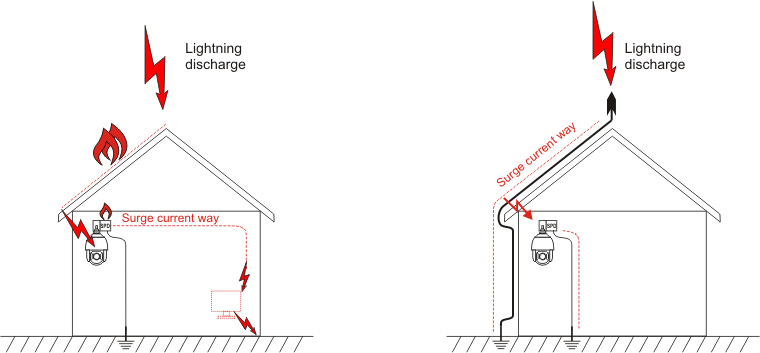
Building without a lightning rod Building with a lightning rod
When the load is brought to the ground by the lightning rod, a strong electromagnetic pulse occurs and a spark may occur to the protected device, but they are neutralized by the protective device.
2. Surge arresters
Statistically direct discharges occur very rarely within a single building, but their impact can be effective within a radius of up to several hundred meters. The occurring strong electric field causes a series of spark-overs and the induction of an electromagnetic field in the installations of nearby buildings. The lack of surge protection systems may damage electronic devices connected to the power supply.
To protect such installations, there are surge arresters (SPD) dedicated to particular types of installations. An effective surge arrester must protect the electronic device against the energy generated by the spark over (a few kA) and the potentials generated between the conductors (up to several hundred amperes). The above-mentioned requirements are met only by combined arresters, selected in such a way that the activation voltage is the closest to the rated voltage for a given type of installation. More information on the rules for selecting surge arresters is described in a separate article.
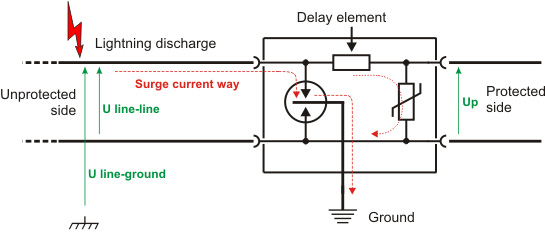
The principle of operation of a combined surge arrester
3. Potential equalisation
Each extensive installation of an electronic system has individual devices mounted at a considerable distance from each other. They can be mounted on metal structures, locally powered and grounded, or connected to other locally grounded components. This creates a risk of potentials between them, which are equalized by transmission cables, which can cause data transmission disturbances and damage to communication interfaces as a result of overcurrent. A particular risk arises during a nearby lightning discharge, which creates very high instantaneous potentials and causes the flow of large equalizing currents. A similar hazard may arise when starting power generators or UPS (Uninterruptible Power Supplies). Industrial facilities with metal halls and impulse devices consuming large amounts of electricity are particularly vulnerable.
A very effective method of eliminating the above-mentioned risks is to install an grounding device.
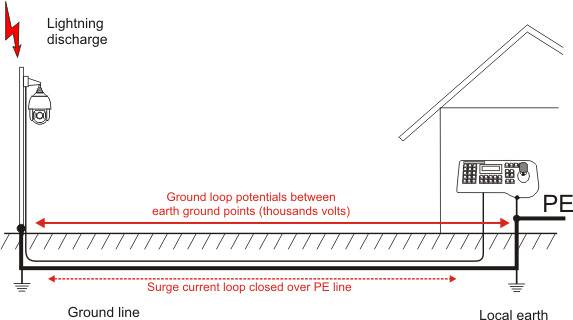
4. Galvanic separation
Many extensive electronic systems are installed when the facilities are already built and finished, along with roads and paths. On many of them, it is not possible to lay PE equalizing lines between each installed device, therefore a galvanic separation is a desirable addition. It can be implemented using various technologies:
- Separating transformers - used in analog and digital transmission, they are cheap, do not require power supply and have a wide bandwidth.
- Optical separators - usually used for digital transmission, they regenerate the digital signal, they have very low losses thanks to the built-in compensation.
- Optical fibers - all devices connected with optical fibers are free from the risk of potential differences and damage caused by them.
Separators must have many compatible parameters to ensure correct operation of devices and are usually dedicated to specific types of signals. Many industrial devices and the LAN network have a built-in separation of individual communication ports.

In addition to long fiber optic connections, all other separators have a limited insulation breakdown voltage. In the case of passive separators, the breakdown voltage is 600-800V, while in active separators, depending on the components used, 1-10kV. This ensures proper protection in the event of distant discharges (several hundred meters) from the installed devices. In the case of discharges occurring at a short distance, the voltages between the grounding point can be much higher, leading to breakdown of the separator. A more effective solution is the combination of separation and combined surge arresters.

5. Grounding of metal structures and protection of other installations
All metal structures, such as gas pipes, central heating installation, metal chimney liners, ventilation ducts, air conditioning, etc., pose a significant risk of bringing the shock charge inside the building and spreading it to electronic devices through a spark over. All electrical and electronic installations with no overvoltage protection outside the building pose the same risk. These include telephone lines, a power grid, antenna installations and even outdoor lighting lamps.
Entire content of this article together with photos is the property of Ewimar Sp. z o.o. and is legally protected. Prohibition of copying and sharing in part or in whole, or use in publications and public presentations.


